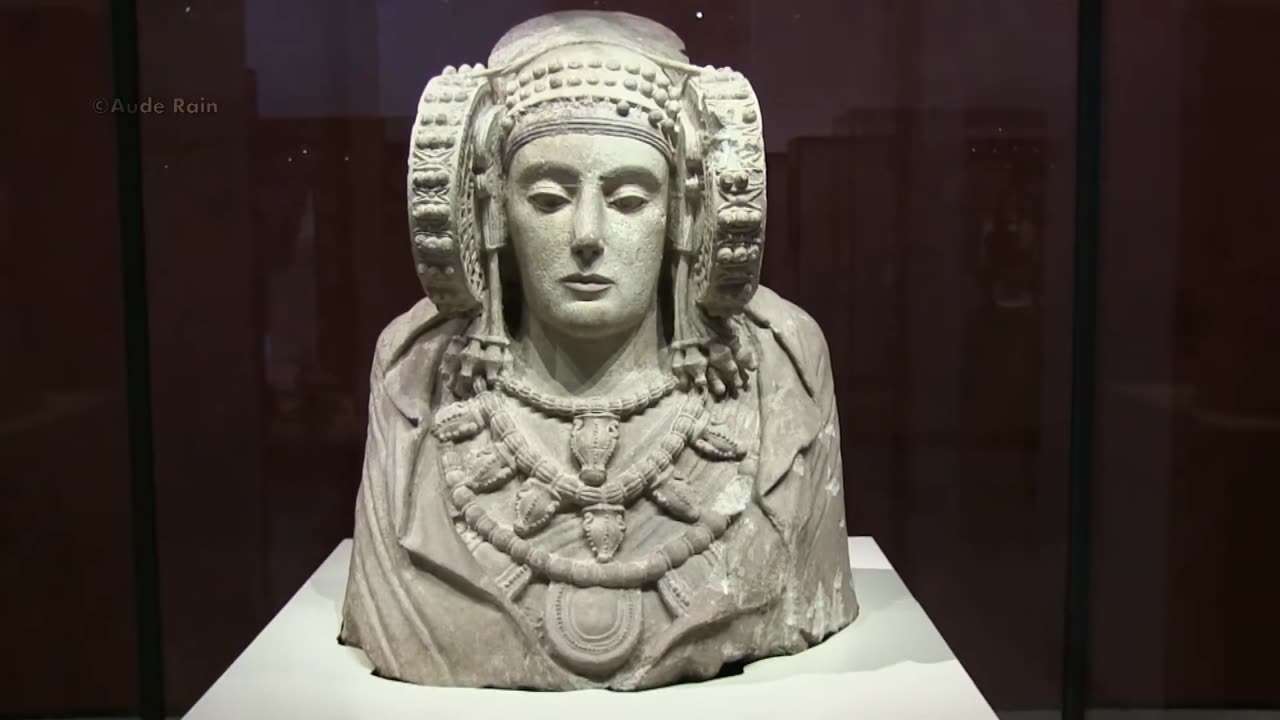Premium Only Content

Gran Dama Oferente, Dama de Elche & Dama de Baza - Madrid
The three ladies from the National Archaeological Museum Madrid - Étude
Great Lady Offerer - Iberian sculpture from the 3rd or 2nd century BC. , made of limestone
Lady of Elche - Iberian sculpture made of limestone between the 5th and 4th centuries B.C.
Lady of Baza - Iberian sculpture from the 4th century BC, carved in polychrome limestone by the Bastetans.
"Lady of Cerro de los Santos, also known as Gran Dama Oferente, is an Iberian sculpture from the 2nd century BCE, that is now in National Archaeological Museum in Madrid.
This limestone sculpture depicts a full-length standing female figure 1.3 metres high. It was found in 1870 in the sanctuary of Cerro de los Santos in Montealegre del Castillo in Albacete province, Spain.
The statue is sometimes called the Gran Dama Oferente because she is holding a container in her two hands and appears to be offering it. She is richly clad in three overlapping robes clasped with a fibula, or brooch, at the neck. Braided hair falls past her three necklaces. She is wearing fitted shoes. A rodete or wheel headgear appears on one side of her hair; if there was a similar one on the other side, it has been broken off. Like another contemporary Phoenician-influenced Iberian female sculpture, the Lady of Baza, her drapery falls in a zigzag pattern.
The Lady of Elx or Lady of Elche : It is generally known as an Iberian artifact from the 4th century BC, although the artisanship suggests strong Hellenistic influences.According to The Encyclopedia of Religion, the Lady of Elche is believed to have a direct association with Tanit, the goddess of Carthage, who was worshiped by the Punic-Iberians. Similarly, the sculpture presents features of the Celtiberian culture (the mitre and the pendants) and the own Iberian (fibula).
The originally polychromed bust is thought to represent a woman wearing an elaborate headdress and large wheel-like coils (known as rodetes) on each side of the face. The opening in the rear of the sculpture indicates it may have been used as a funerary urn.
The Lady of Baza (la Dama de Baza) is a famous example of Iberian sculpture by the Bastetani. It is a limestone female figure with traces of painted detail in a stuccoed surface that was found on July 22, 1971, by Francisco José Presedo Velo, at Baza, in the Altiplano de Granada, the high tableland in the northeast of the province of Granada. The town of Baza was the site of the Ibero-Roman city of Basti and, in one of its two necropoleis, the Cerro del Santuario, the Lady of Baza was recovered. She is seated in an armchair, and an open space on the side is thought to have contained ashes from a cremation." wikipedia
-
 LIVE
LIVE
BrancoFXDC
1 hour agoWarzone Rebirth Rounds
270 watching -
 1:44:14
1:44:14
Glenn Greenwald
7 hours agoRubio's Shift: What is Trump's Foreign Policy? Trump/Musk Attack CIA Fronts USAID & NED: With Mike Benz | SYSTEM UPDATE #401
55.6K49 -
 1:05:47
1:05:47
Donald Trump Jr.
9 hours agoMexico Sends Troops to Border, Plus USAid Scam Exposed, Live with Brooke Goldstein & Rep Brian Mast | TRIGGERED Ep.213
200K147 -
 9:26
9:26
Rethinking the Dollar
5 hours agoUnbelievable Government Waste: 5 Outrageous Biden-Era Spending Sprees
4.04K7 -
 LIVE
LIVE
Flyover Conservatives
22 hours agoDR. KIRK ELLIOTT | Deep Dive: Tariffs, Tech, and Total Economic Warfare – Who Wins and Who Loses? | In Studio - FOC Show
1,288 watching -
 LIVE
LIVE
Danny Polishchuk
6 hours agoTariffs and Trade Wars + Nick Rochefort | Low Value Mail #136
392 watching -
 LIVE
LIVE
I_Came_With_Fire_Podcast
9 hours agoCartels vs The United States, Fentanyls 2 Front WAR, and FTOs
189 watching -
 4:54
4:54
CryptoWrld
9 hours agoCrypto Startup Launches Tokenized US Treasury Bonds
7.7K2 -
 LIVE
LIVE
We Like Shooting
15 hours ago $0.03 earnedWe Like Shooting 596 (Gun Podcast)
265 watching -
 54:43
54:43
Kimberly Guilfoyle
8 hours agoThe Trump Effect: Mexico Folds, Live with Dinesh D’Souza & Chuck DeVore | Ep.193
89.2K32